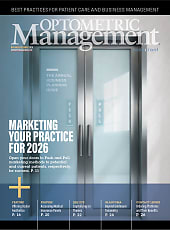IN DAILY PRACTICE, patient habits often determine the success or failure of treatment—whether in managing dry eye, ensuring proper contact lens wear, or slowing the progression of myopia. Many tools available today harness artificial intelligence (AI) to help patients monitor behaviors and environments that directly affect their ocular health. These tools can be recommended and integrated into patient care to improve outcomes with little to no learning curve.

Patient compliance with recommended contact lens wear time and replacement schedules has long been a priority that physicians struggle with. Several AI-powered mobile apps are now available that track lens wear time, analyze user behavior, and send reminders when it’s time to remove or replace lenses. These tools often incorporate image recognition or behavioral algorithms to make suggestions based on patterns of use. Such apps are typically found in health or vision care sections of app stores and offer cloud synchronization with mobile calendars. A quick search (eg, “AI contact lens wear time tracker”) can lead patients to reputable options.
With the rise in pediatric myopia, tools that monitor screen distance have become increasingly important. One smartphone’s operating system includes a feature that uses the phone’s camera system to measure how close a user’s face is to their device. When the device is held too close to the eyes for prolonged periods, the user is prompted to increase their viewing distance, thus reducing eye strain and helping to slow myopia progression. The manufacturer states this feature was developed in response to the global increase in myopia, particularly in children (Apple Inc., 2025), and it is supported by research suggesting that excessive near-range work is a significant factor in its development (Apple Inc., 2023; Huang et al, 2015). Other major smartphone operating systems do not currently offer an identical native feature, though third-party apps with similar functions are available.
AI-assisted parental controls on smartphones can now also monitor and limit children’s screen time, which is a factor closely linked to digital eye strain and myopia (Demirayak et al, 2022; Ha et al, 2025). On some phones, parents can define daily usage caps. Others can use “well-being” apps that provide similar controls. Practitioners can work with parents to determine appropriate screen time limits based on the child’s age (for example, less than 1 hour per day for children under 10, and 2 hours for those under 16). These recommendations may vary depending on the patient’s needs and clinical guidance, but equipping families with tools to monitor screen exposure is a key part of modern pediatric eye care.
AI technologies are already in the hands of our patients through smartphones and wearable integrations, and they offer powerful ways to increase treatment success. By understanding and recommending tools like wear-time tracking, screen distance monitoring, and parental controls for screen time, practitioners can better educate and empower their patients. These AI-powered solutions are not just futuristic add-ons; they’re current practical resources that allow for personalized care, proactive management, and improved long-term outcomes in eye health.
References
1. Apple provides powerful insights into new areas of health. Press release. Apple Inc. August 28, 2025. Accessed October 7, 2025. https://www.apple.com/newsroom/2023/06/apple-provides-powerful-insights-into-new-areas-of-health/
2. Help protect your vision health with Screen Distance on iPhone. In IPhone User Guide. Accessed October 7, 2025. https://support.apple.com/guide/iphone/protect-vision-health-screen-distance-ipha56b14d75/ios
3. Huang H-M, Chang DS-T, Wu P-C. The association between near work activities and myopia in children: a systematic review and meta-analysis. PLoS One. 2015;10(10):e0140419. doi:10.1371/journal.pone.0140419
4. Demirayak B, Tugan BY, Toprak M, Çinik R. Digital eye strain and its associated factors in children during the COVID-19 pandemic. Indian J Ophthalmol. 2022;70(3):988-992. doi:10.4103/ijo.IJO_1920_21
5. Ha A, Lee YJ, Lee M, Shim SR, Kim YK. Digital screen time and myopia: a systematic review and dose-response meta-analysis. JAMA Netw Open. 2025;8(2):e2460026. doi:10.1001/jamanetworkopen.2024.60026




